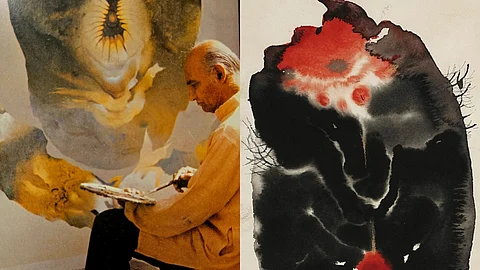
- HOMEGROWN WORLD
- #HGCREATORS
- #HGEXPLORE
- #HGVOICES
- #HGSHOP
- CAREERS
- ABOUT US
- CONTACT US

In the small town of Behrampur, Bengal, in 1917, was a little boy who was smitten by the world around him. As a result, he wanted to be an artist. But back home, his family had other ideas. To them, his fascination with art was nothing more than a waste of time. Yet, that didn’t stop Bimal. His awe for nature and the universe was far stronger than their disapproval. By the time he moved to Delhi to live with his uncle, who was equally dismissive of his artistic dreams, Bimal had already made up his mind. He clung to his dreams with a tenacity that eventually saw him enroll at the Government College of Arts and Crafts, Calcutta, in 1937. And that’s where the journey of India's first abstractionist truly began.
But life had other plans. The outbreak of World War II interrupted his education, forcing him into a clerk's job in the war office. Ironically, it was here that his talent found an unlikely canvas as he created artwork for Victory, a wartime magazine. Even amidst war and adversity, his passion for art remained steadfast, and by 1943, he earned his diploma. From this point, his career bloomed into a blend of teaching, creating, and pioneering movements that would place him at the forefront of Indian modernism.
Bimal Das Gupta’s art was never merely about forms or colours; these were tools he used to design entire worlds. Early in his career, he made a name for himself as a landscape painter, capturing nature in its most evocative forms. But the soul of his work lay in his abstract interpretations. With a deep fascination for Indian philosophy, particularly Tantra, Das Gupta’s works explored themes of creation, cosmic balance, and the infinite cycles of life and regeneration. Untitled, for example, produced in 1984, an acrylic and charcoal piece visualizes the birth of the universe. The yellow sun emerges from oceanic depths, a metaphor for life springing forth from chaos, it was a visual hymn to the mysteries of existence.
Bimal’s artistic vocabulary matured further during a six-month European scholarship, where exposure to gouache and oil transformed his approach. But an allergy to oil paints forced him to innovate, leading to his mastery of watercolors, acrylics, and mixed media. This restriction became his liberation — he mixed mediums with a daring creativity, birthing textures and effects that rivaled the depth of oils.
Before the Neo-Tantra movement swept through Indian modernism in the 1960s, Bimal had already been delving into the visual and spiritual language of Tantra since the late 1940s. His abstract works, imbued with sacred geometry and cosmic symbolism, offered a contemporary lens to esoteric Indian philosophies. One of his untitled works from 1993, for instance, epitomizes this fusion. The swirling gestures on the canvas symbolize the 'yoni', the feminine principle in Tantra, which, paired with the masculine 'linga', signifies the eternal dance of creation and regeneration. In another remarkable piece from 1992, rendered in gouache, pastel, and charcoal, the artist used an effusion of blues with a striking streak of red to represent fertility and Shakti, the life force. The visual interplay between colours and forms evokes a sense of awe — an invitation to contemplate the origins of existence.
Nature was a spiritual anchor for Bimal Das Gupta. His early landscapes, influenced by cubism and later abstraction, gradually evolved into profound meditations on humanity’s relationship with the environment. Using watercolors, charcoal, and gouache, he painted a barren tree standing on desolate, sandy land in a piece from 1994. Feather remnants hint at birds lost to a now lifeless ecosystem. The work is both a lament and a call to action; a poignant reminder of nature’s fragility in the face of human interference.
Bimal’s brilliance wasn’t confined to galleries. His works traveled across the globe, from the São Paulo Biennale in 1965 to the Festival of India in Paris and Moscow in the mid-1980s. His murals adorned India’s pavilions at international trade fairs across the world, embodying the country’s artistic expression on a global stage. Despite this international acclaim, he remained deeply connected to his roots. His art, whether a cosmic abstraction or a depiction of nature, carried the ethos of Indian philosophy, merging the nation's values with modernist experimentation.
Bimal Das Gupta passed away in 1995 in a car accident, leaving behind a legacy as India’s first Neo-Tantric abstractionist and a pioneer of modernism. His awards, including the Kala Ratna by AIFACS and a fellowship from the Lalit Kala Akademi, barely scratch the surface of his contributions. His true accolades lie in the universes he painted, the philosophies he visualized, and the inspiration he continues to provide.
At a time when most artists were illustrating the tangible world around them, Bimal Das Gupta dared to open a portal between realms, exploring the intangible essence of existence through his mesmerizing abstractions. While his work gained recognition globally during his lifetime, it was in India that his genius truly found appreciation posthumously. His earthy colour palette, with its film-like hues, fits right into today's visual culture. Bimal's paintings still resonate with people after all these decades because it taps into something timeless and personal: man’s relationship with the infinite and the larger forces of nature. His art remains a cosmic conversation, one that continues to whisper truths about life, creation, and the universe.
If you enjoyed reading this here's more from Homegrown:
How Bengali Modernist Painter Gobardhan Ash Challenged Traditional Artistic Expression
Celebrating The Legacy Of Meera Mukherjee: A Sculptor, Painter, Diarist, & Activist
Enigmatic Excellence: The Artistic Legacy Of Iconic Kerala Painter C.N. Karunakaran
